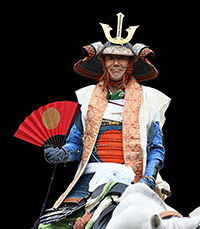
The JidaMatsuriis a festivathat takes place everv vear on October 22the anniversarv of the foundatior of Kyoto. It consists of a large parade that travels from the Imperial Palace to Heian Shrine. Jidai Matsuri is Japanese for "Festival of Ages"and the participants of the parade are dressed in accurate costumes from almost every period of Japanese history, as well as famous historical figures.There are about 2000 participants and it takes two hours to watch the entire procession pass by The Jida Matsuri is held bv Heian Shrine and both the festival and the shrine were established in 1895 to celebrate Kyoto's history and culture. A few years before in 1868the capital was moved to Tokyo afte havina been in Kvoto for over a thousand vearsDespite its short historvthe Jidai Matsuri is one of Kvoto's three most famous festivals.along with the Gion Matsuri in July and the Aoi Matsuri in Mav The historical costumes and characters that are displayed in the parade cover the approximately 1100 years during which Kyoto was the national capital.The procession is separated into historical eras and then further separated into themes,of which there are about twenty.The parade begins with characters from the Meii Restoration in 1868.and then continues in reverse chronological order until the beainning of the Heian Period in 781.

Foreword by TARUMI Hideo,
Ambassador Extraordinary and Plenipotentiary of Japan to the People’s Republic of ChinaMore than 10 year have passed since I started my path as a photographer, and from the very beginning, I was mesmerized by the profound world of photographs. I have traveled to various places both in Japan and China, and captured countless beautiful scenes with my cameras. Through photo-taking, I could get acquainted with many photographers. Mr. Zhao Hui is one of such photographers with whom I developed a strong friendship.
“Japan Story” is a collection of Mr. Zhao’s photo works featuring “Jidai Matsuri (Jidai Festival)”, which is one of the three great festivals in Kyoto. As a matter of fact, Kyoto is the place where I spent my college days, and his works take me back to my own college days with a sense of nostalgia.
Since ancient times, Japan has maintained its tradition of learning so much from other civilizations such as those of China and the Western world, integrating those into its own culture, and further developing what it has learned from others. As such, through such process, Japan’s culture, from traditional one to modern and popular one, has come to enjoy both “uniqueness” and “universal appeal”.
Looking at the photo works in this collection, we can observe the evolution of what people in Kyoto wore in each different period over the last 1,200 years. At the same time, these photo works remind us that the ancient costumes of Japan were developed under the profound influence of Chinese culture, and that Japanese costume culture has a unique history of evolution.
Japan and China are neighbors that cannot move away from each other. In addition, this year marks the 50th anniversary of the normalization of diplomatic relations between Japan and China. I sincerely hope that this collection will encourage more people to stimulate imagination and develop interest in Japan, and by doing so, adding a special touch to the bond of cultural exchanges and cooperation between Japan and China.





